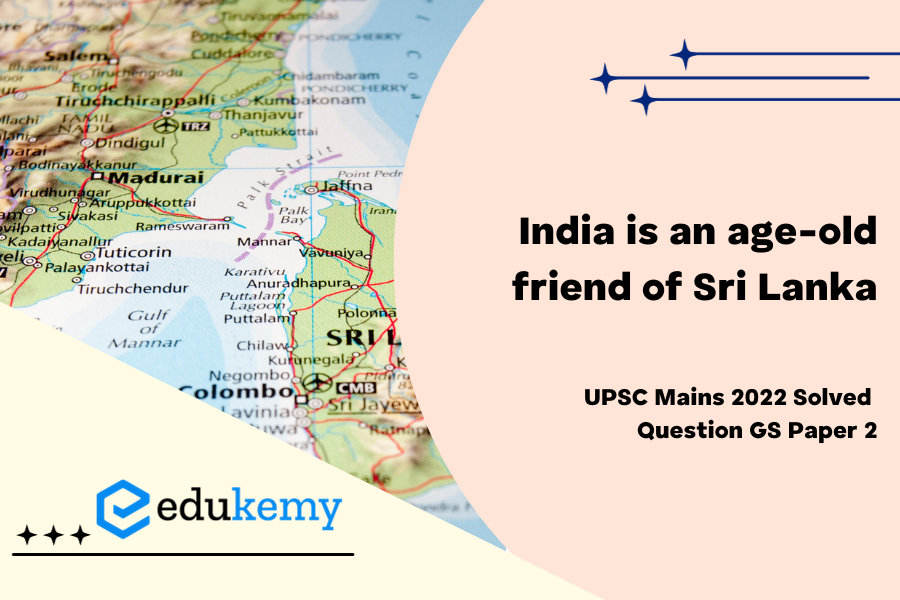India’s longstanding relationship with Sri Lanka has evolved into a multifaceted partnership. Amid the recent crisis, India’s engagement showcased its commitment to regional stability, emphasizing support for Sri Lanka while respecting its sovereignty. Striking a delicate balance, India prioritized maintaining friendly ties while advocating for peaceful resolution and stability in the region.
UPSC Mains General Studies Paper – 2 Mains 2022
UPSC Mains Civil Services IAS Exam Question Paper – 2022
Theme: India-SriLankan Bilateral Relation
Contents
Approach
Introduction: Write how India is honoring the old-age friendship with Sri Lankan in the wake of the Economic Crisis in Sri Lanka.
Body
- Briefly write the major factors responsible for this crisis.
- How India is helping Sri Lanka in overcoming the Economic Crisis.
- Write the challenges India is facing in strengthening this old-age friendship.
Way Forward: Write what should be India’s approach in the given situation for strengthening India-Sri Lanka Bilateral Ties.
Conclusion: Write about the driving force behind India’s proactive approach in dealings with Crisis-hit Sri Lanka.
Answer
Introduction
Recently, Defence Minister Rajnath Singh said that apart from being a neighbour, Sri Lanka is an old friend of India and it is New Delhi’s duty to stand with Colombo during the time of crisis since Sri Lanka is India’s strategic partner and closest maritime partner.

Body
Sri Lanka is undergoing an unprecedented economic crisis that has now worsened to become a humanitarian crisis. Years of mismanagement and faulty economic policies, adopted by the government, have landed the nation into a debt-to-credit ratio of 111 %. “Debt Trap Diplomacy ” of China, Impact of Covid-19 Pandemic on Tourism and radical steps to promote organic agriculture have played a major role in intensifying this crisis.
India’s Role in Sri Lanka crisis: Strengthening Old-Age friendship
- Financial Assistance: India extended financial aid of $4 billion to keep the country’s accounts afloat and has also supported Colombo’s demands for an International Monetary Fund bailout package and restructuring of its debt.
- Humanitarian Assistance: For instance, Indian naval ship Gharial was deployed to deliver 760 kg of critical lifesaving medicines to Sri Lanka.
- Reviving Tourism: Initiatives such as the Air bubble arrangement between India and Sri Lanka, and the inaugural flight from Sri Lanka to Kushinagar are the major developments to revive the Pandemic hit Tourism sector of Sri Lanka
- Energy Security: India has entered into several cooperative arrangements to strengthen the energy sector such as Agreement to jointly develop the Trincomalee oil tanks farm, for developing a 100 MW Solar Power Plant at Sampur, a deal for setting up two renewable energy projects in Northern Sri Lanka.
Challenges
- Anti-Indian sentiments in Sri Lanka: Sinhalese community in Sri Lanka have been sceptical about India’s financial and humanitarian aid to Sri Lanka given India’s long-standing position regarding a credible power devolution based on the 13th Amendment to the Constitution of Sri Lanka to the northern and eastern provinces of the country.
- Chinese Presence in Sri Lanka: Beijing is rigorously engaging Colombo to sign a Free Trade Agreement (FTA) which China advocate as a credible solution for Sri Lanka to tide over the foreign exchange crisis in the long run.
Way Forward
- Countering Chinese Influence: Given the Sino-Indian geopolitical rivalry, coupled with India’s aspiration of being a net provider of security and stability in the Indo-Pacific region, New Delhi must deepen its developmental and humanitarian engagements in Sri Lanka.
- Beyond ‘Neighbourhood First Policy’: India must balance Chinese transactional relationship with Sri Lanka with its mature and inclusive approach. India’s broad policy Outlook should have space for honouring Sri Lankan sensitivities, given the Chinese debt burden on Sri Lanka.
- Non-Transactional Nature of Assistance: Given India’s limitations to match China’s capabilities of economic assistance, India’s approach should be ‘humanitarian’ and non-transactional in outlook to generate goodwill in her favour.
Conclusion
India’s assistance to Sri Lanka is in line with its policy of “neighbourhood first” and vision for “Security and Growth for All (SAGAR).” These twin principles underline India’s emphasis on emerging as a first respondent as to meet the requirements of neighbouring countries in emergency and crisis situations.
In case you still have your doubts, contact us on 8792740517.
For UPSC Prelims Resources, Click here
For Daily Updates and Study Material:
Join our Telegram Channel – Edukemy for IAS
- 1. Learn through Videos – here
- 2. Be Exam Ready by Practicing Daily MCQs – here
- 3. Daily Newsletter – Get all your Current Affairs Covered – here
- 4. Mains Answer Writing Practice – here


